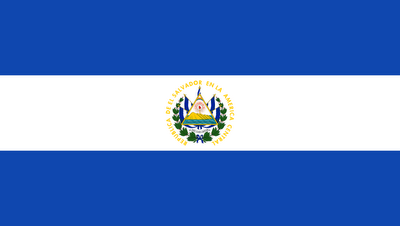El Salvador, just over 6 million people, densely crammed in the smallest country of the 7 that occupy the Central American isthmus, on a territory the size of a small north-eastern American state.
above: El Salvador's flag
In the country for a week (after attending business at Victoria - Transmission Global Summit 2012; flew from Vancouver - overnight at Fairmont Airport Hotel - on Continental Airlines via Houston). To join Cynthia doing some voluntary work (she, not me!) at Suchitoto, as part of a small team of Stratford Shakespeare Theatre people, helping out local theatre troop esArtes (see further blog entries)...
A country defined in our mind by the events of the last 20-30 years: violence – civil war (all of the 1980’s; a peace deal was put together in 1992, between the FMLN – Farabuno Marti National Liberation Front – and the right-wing, US-backed, military government); high homicide and gang fights afterwards; natural disasters (1998 – Hurricane Mitch, hundreds dead, thousands homeless; massive earthquakes in 2001 and 2005, etc.). And poverty – it goes along!
Violence, that a visitor will experience in history, but not in the reality of his or her stay (it is very safe, if you stay away from gang areas at night – which one wouldn’t go to anyway – and take some minimum precautions that apply to every situation when one is travelling!)
When one reads some of the history of the country, you can see where the violence is coming from: remnants of 3 centuries of Spanish colonialism (to 1821); followed by domination exercised by a few landowner families (owners of coffee plantations; coffee, replacing indigo as main export, used around 1900 to account for 95% of foreign exports); revolts from non-owner peasants (the”campesinos”), which were crushed (e.g. “La Matanza”, the peasant revolt in 1932; also the “Mozote Massacre” later on, at the beginning of the civil war in 1981). Political polarization as a result; civil war follows naturally. People movements: gangs expelled from US, re-incarnated in El Salvador. All that fuelled by continuing poverty and unequal distribution of wealth, between a well-to-do small minority, and the rest of the people…
above: a map of El Salvador; its 14 departments
El Salvador has a somewhat special relation with the US, and not only because of the support the latter offered the military government during the civil war - $7B! The country went as far as seeking statehood in the US immediately after independence from Spain in 1821! Also it is said that roughly 2 million Salvadorans (or Salvadoreans – we could not get a firm judgment on the spelling!), the equivalent of a third of the country’s population, live illegally in the United States, sending some US$3.5B home in remittances, yearly, which would account for 15% of the country’s GDP!)Altogehter, more than the equivalent of half of the country's population still lives abroad...
A new era, with the current elected (2009) moderate president, Mauricio Funes, backed by the now legitimized FMLN.
This used to be the land of the Maya (along with the Yucatan and other Central American countries north of El Salvador). At the height of Maya civilization (right up to the 10th century AD), there was perhaps 10 million Maya, dispersed on that land, in various city-states (no centralized ruler, unlike the Incas in Peru). It all came crashing down around A.D. 900 for no explainable reason (except a variety of cited causes – famine, warfare, deforestation, fatal volcanic eruptions, etc.) We are left with ruins – the better known here in El Salvador is at Tazumal, in the west of the country – and a prophecy: the world as we know it will end this year on December 21!!! (However, see separate blog entry on that very topic!)above: a picture of Maya's ruins, at Tazumal. Photo license Creative Commons
Intriguing: there was an attempt at federalism between Central American countries (the Central American Federation) a couple of years after the liberation from Spanish colonialism in 1821, but it did not last: it was dissolved in 1838, victim of tensions, it would appear, between different ideologies (liberals and conservatives – a loose versus a centralized federation?), and strong centrifuge local powers and interests which eventually prevailed…
San Salvador, February 13, 2012


